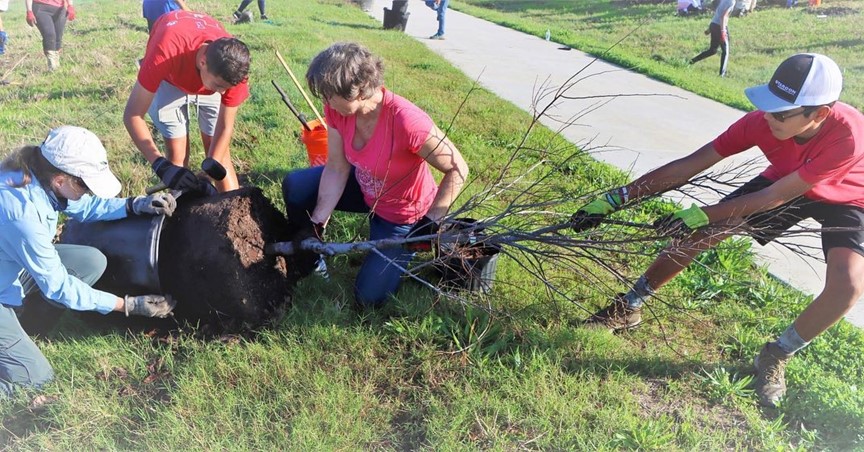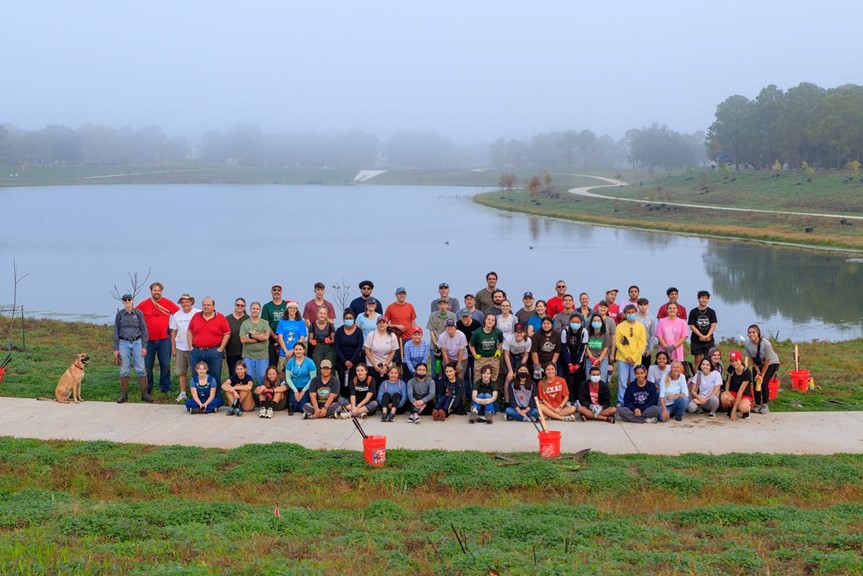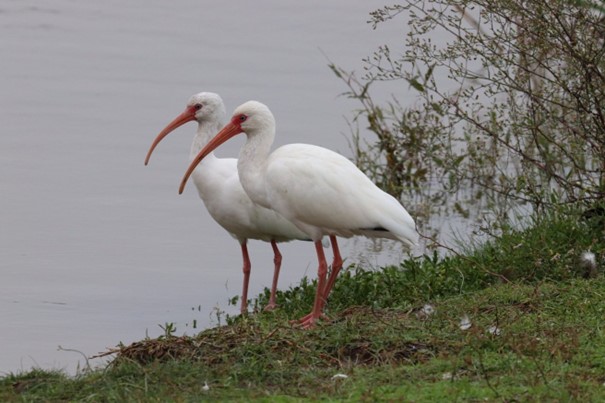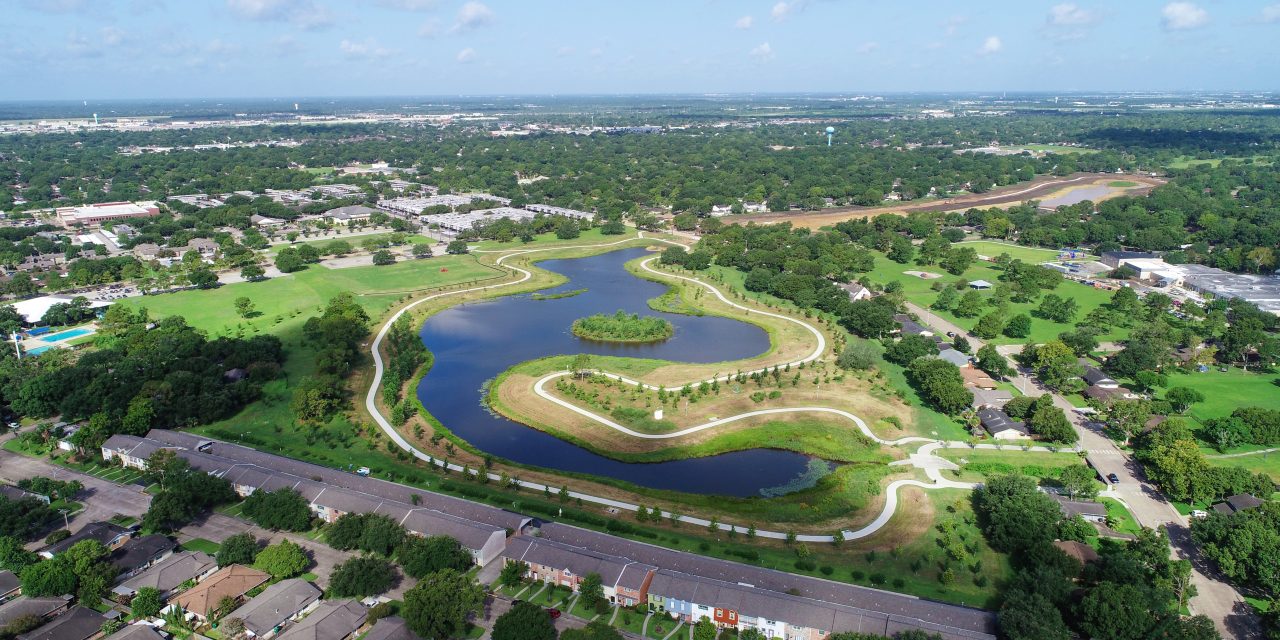Just outside Houston, a redevelopment project nearly a decade in the making has transformed the former site of a 72-ha (178-ac) golf course into a multifunctional stormwater management hub called Exploration Green. The effort, spearheaded by the Clear Lake City Water Authority (CLCWA) and its nonprofit partner, the Exploration Green Conservancy, demonstrates how nature-based approaches can reliably mitigate flooding, provide recreational opportunities, and boost the local economy.
Project partners celebrated the conclusion of Exploration Green’s fifth and final stage of construction during a ribbon-cutting ceremony in September 2023. The completed project boasts vast expanses of new wetlands and native grasslands — along with five massive stormwater detention ponds — that will improve water quality and circulation significantly throughout approximately 3,200 ha (8,000 ac) of flood-prone land between Houston and the Gulf of Mexico.
Exploration Green already has earned an array of awards for its scope and efficacy as well as its delivery process, which championed a robust and proactive approach to public outreach from its earliest stages. Effectively attracting and mobilizing volunteers enabled the project team to minimize construction costs and build enduring public investment in the project’s success. Now, as partners look toward ongoing maintenance, Exploration Green’s substantial public support continues to pay dividends. David Sharp, Exploration Green Conservancy Chairman, describes consistently high volunteer turnout for tree plantings, invasives removals, litter cleanups, and other upkeep efforts.
“We’ve got such a strong, broad base of support,” Sharp said. “We’ve never been short of volunteers from the community. Our key challenge has been, ‘What are we going to do with all these people?’”
A Natural Fit for Southeast Texas
The former Clear Lake Golf Course was a fixture within the master-planned, residential community through which it meandered. It featured carefully designed curves and contours bound to the natural topography that provided a useful foundation for Exploration Green’s layout. Project planners capitalized on the site’s existing slopes to create a 100% passive, gravity-fed stormwater management process, featuring strategically placed landscapes that work together to direct runoff into Clear Lake and its tributary streams. That water, which undergoes natural treatment via wetlands, then flows into Galveston Bay and ultimately the Gulf of Mexico.

The technical centerpiece of Exploration Green is its stormwater detention ponds, each of which can hold 378.5 million L (100 million gal). The ponds, bordered by extensive wetlands, collect runoff from around the site and protect more than 2,000 homes in the project’s vicinity from flooding during major storms. Further, irrigation water for the site originates solely from unchlorinated effluent supplied by a nearby, CLCWA-operated water resource recovery facility, minimizing Exploration Green’s water footprint.
However, planners paid equal attention to community amenities — Exploration Green features 9.5 km (6 mi) of hiking and biking trails, two athletic fields, and numerous open green spaces primed for public gatherings.
Plans for Exploration Green began as early as 2013, when CLCWA established the Exploration Green Conservancy. For many, the need for a comprehensive, purpose-built, flood-mitigation solution in the chronically flood-prone Clear Lake area already was apparent, Sharp said. However, Hurricane Harvey’s arrival in August 2017 made this need far more visible — and also demonstrated Exploration Green’s value.
“Everybody that lives here knows that every hurricane season, we’re under threat of catastrophic rainfall,” Sharp said. “The first phase of Exploration Green was about 80% complete when Harvey struck, and it worked exactly as planned. It proved the concept, and protected a couple hundred homes in the adjacent area that would normally flood with any kind of heavy rainfall at all. They didn’t experience any flooding during Harvey.”

Exploration Green’s original timeline called for an expected delivery in 2030. Its performance during Hurricane Harvey prompted calls for CLCWA to expedite its construction to 2023. The project’s benefits became increasingly clear even well before its completion.
“Since Harvey, we’ve had probably about five or six tropical events,” Sharp said. “We’ve seen very little flooding into people’s houses around Exploration Green as a result of any of those events.”
Exploration Green also has proven popular for its recreational opportunities. Sharp estimates that about 200 to 300 people visit the site each day, and the facility also hosts a range of community events. Also, wildlife has returned to the area in droves — Exploration Green now is home to more than 600 species of plants and animals, attracting bird-watchers, moth-hunters, and other nature lovers.
The project also represents a boon for the local economy.
“Once Exploration Green came in, we began to see people fixing up their houses and property values rising faster than other subdivisions in the area,” Sharp said. “People have a bit more civic pride. The value of the houses that are backing up to the green is skyrocketing.”
Engage Early, Engage Often
Despite an expedited timeline and the onset of the COVID-19 pandemic, Sharp describes the process of delivering Exploration Green as relatively seamless for a project of its size.
Securing robust community support for the effort was key to avoiding delays, he said. The project team hosted several town hall meetings during the design and construction phases and endeavored to incorporate neighbors’ preferences and concerns into their plans. As the lion’s share of Exploration Green’s roughly USD $50 million price was funded via voter-approved municipal bonds, earning public support was critical to the project’s success.
“We found that by going public with the plans early on, there was a lot of support that just kind of materialized,” Sharp said.
For example, as parts of Exploration Green wind through residential subdivisions, neighbors expressed worry that trailgoers would be able to see directly into their homes. The team responded by building trails along a downward slope toward Clear Lake, creating a natural division between recreational areas and backyards.

“When you think about a stormwater detention facility, that can just be nothing more than a flat-bottom hole in the ground with a chain-link fence around it,” Sharp said. “The community definitely did not want that.”
Town hall meetings also attracted new partners — representatives from the Galveston Bay Foundation (Kemah, Texas) approached the project team during one meeting, which proved instrumental in securing conversation easements from the state, Sharp said. Similarly, Trees for Houston committed to contributing 5,000 native trees to Exploration Green during another community meeting. Other partners included Texas A&M University’s AgriLife Extension Service (College Station), who provided an onsite wetland plant nursery that ensures a steady source of transplantable vegetation. The nursery also serves an educational purpose, hosting internships that teach students about green infrastructure and environmental stewardship.
Although Exploration Green’s delivery phase is concluding, the project team still is emphasizing public outreach as an ongoing approach to upkeep. Members of the Exploration Green Conservancy routinely monitor neighborhood forums such as Nextdoor for mentions of onsite problems, which they then proactively work to address.
In addition to a maximalist approach to community engagement, Sharp also advises other utilities considering large-scale stormwater projects such as Exploration Green to establish a dedicated, nonprofit partner such as the Exploration Green Conservancy. Although creating the Exploration Green Conservancy required incorporation with the state government and significant legal work to secure tax-exempt status, Sharp emphasizes that it did not entail an exorbitant financial investment. These partners can supplement the utility’s mission by focusing on education and public engagement, as well as apply for grant funding that otherwise would be off-limits for government entities.
Learn more about the Exploration Green project at its website.
Top image courtesy of Lockwood, Andrews and Newnam Inc. (Houston)

ABOUT THE AUTHOR
Justin Jacques is editor of Stormwater Report and a staff member of the Water Environment Federation (WEF). In addition to writing for WEF’s online publications, he also contributes to Water Environment & Technology magazine. Contact him at jjacques@wef.org.




